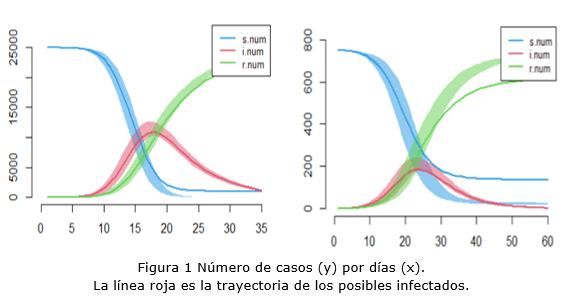Need for improvement in mathematical models of epidemiology
Keywords:
Modelos matemáticos, educación, posgrado, epidemiología, COVID-19Abstract
Introduction: In Cuba mathematical models are formulated, but they are not contemplated for passing graduate or undergraduate degrees.
Objective: To identify the need to work with mathematical simulations.
Methods: A stochastic model present in the EpiModel package of the R program was used. Three different situations were simulated, the first with violations of distancing and general hygiene, the second with improvements in these two aspects, plus the immunity achieved to 70% of the population by vaccination and the third with notable improvements in hygiene and distancing together with vaccination. The behavior of the reproductive number with the early R package was also calculated from the incidence.
Results: It is assessed how the trajectories with the stochastic models have more variability and how the reduction of contacts flattens the curve. The spread of the epidemic is valued in situations of prevention violations and in others where there is prevention and also vaccination.
Conclusions: Sufficient evidence is presented on the use and need of mathematical models to support decision-making in epidemiology, the need to improve the theory of epidemics in graduate school is identified, which can be extended to undergraduate.
DeCS: MATHEMATICAL CONCEPTS; ANALYTICAL EPIDEMIOLOGY; EPIDEMIOLOGIC MODELS; TIME SERIES STUDIES; COVID-19.
Downloads
References
1. Castilla MÁ, Guerra MF, Villadiego EM. Salud pública: un campo de confrontación del paradigma disciplinar y transdisciplinar. Revista Avances En Salud [Internet]. 2018 [citado 06 Jul 2021];2(2):48-57. Disponible en: https://revistas.unicordoba.edu.co/index.php/avancesalud/article/view/1457
2. Más Bermejo P, Vidal Ledo MJ, Baldoquín Rodríguez W, Seuc Jo AH, Guinovart Díaz R, Pérez Rodríguez N, et al. Organización de la investigación epidemiológica para la lucha antiepidémica contra la COVID-19 en Cuba. INFODIR [Internet]. 2020 [citado 08 Jul 2021];32. Disponible en: http://revinfodir.sld.cu/index.php/infodir/article/view/831/1304
3. Nuno Martins P. A transdisciplinary perspective of the current crisis situation in the world. EPRA IJMR [Internet]. 2020 May [citado 08 Ago 2021];6(5):2455-3662. Disponible en: https://eprajournals.com/jpanel/upload/3.EPRA%20JOURNALS-4404.pdf
4. Moradian N, Ochs HD, Hamblin MR, Camargo CA, Martinez JA, Biamonte JD, et al. The urgent need for integrated science to fight COVID‑19 pandemic and beyond. J Transl Med [Internet]. 2020 [citado 12 Ago 2021];18:25. Disponible en: https://translational-medicine.biomedcentral.com/articles/10.1186/s12967-020-02364-2
5. Laupacis A. Working together to contain and manage COVID-19. CMAJ [Internet]. 2020 Mar [citado 15 Ago 2021];192(13):E340-1. Disponible en: https://www.ncbi.nlm.nih.gov/pmc/articles/PMC7124162/.
6. Smetschka B, Gaube V. Co-creating formalized models: Participatory modelling as method and process in transdisciplinary research and its impact potentials. Environmental Science and Policy [Internet]. 2020 [citado 19 Ago 2021];103:41-49. Disponible en: https://enviro2.doe.gov.my/ekmc/wp-content/uploads/2020/07/Co-creating-formalized-models-Participatory-modelling-as-_2020_Environmenta.pdf
7. Jenness SM, Goodreau SM, Morris M. EpiModel: An R Package for Mathematical Modeling of Infectious Disease over Networks. J Stat Softw [Internet]. 2018 Abr [citado 19 Ago 2021];84:8. Disponible en: https://www.ncbi.nlm.nih.gov/pmc/articles/PMC5931789/.
8. Core Team R. R: A language and environment for statistical computing. R Foundation for Statistical Computing [Internet]. Viena: GBIF; 2018 [citado 06 Ago 2021]. Disponible en: https://www.gbif.org/es/tool/81287/r-a-language-and-environment-for-statistical-computing
9. Abelló Ugalde IA, Guinovart Díaz R, Morales Lezca W. El modelo SIR básico y políticas antiepidémicas de salud pública para la COVID-19 en Cuba. Rev cuba salud pública [Internet]. 2020 [citado 09 Ago 2021];46(Suppl 1):e2597. Disponible en: http://scielo.sld.cu/scielo.php?script=sci_arttext&pid=S0864-34662020000500013
10. Ortigoza G, Lorandi A, Neri I. Simulación Numérica y Modelación Matemática de la propagación del Covid 19 en el estado de Veracruz. Rev Mex Med Forense [Internet]. 2020 [citado 06 Ago 2021];5(3):21-37. Disponible en: https://www.medigraphic.com/pdfs/forense/mmf-2020/mmf203c.pdf
11. Sánchez Vargas HE, Beltrán Ramos-Sánchez L, Galindo-Llanes PA, Salgado Rodríguez A. Modelación físico-matemática para la toma de decisiones frente a la COVID-19 en Cuba. Rev retos [Internet]. 2020 Jul-Dic [citado 06 Ago 2021];14(2):55-86. Disponible en: http://scielo.sld.cu/scielo.php?script=sci_arttext&pid=S2306-91552020000200054
12. Estrada Álvarez JM, Ospina Ramírez JJ, Hincapié Acuña M, Gómez González MP. Estimación del intervalo serial y número reproductivo básico para los casos importados de COVID-19. Rev salud pública [Internet]. 2020 Mar-Abr [citado 12 Ago 2021];22(2). Disponible en: http://www.scielo.org.co/scielo.php?script=sci_arttext&pid=S0124-00642020000200214&lng=en&nrm=iso
13. Amster P. La matemática de las epidemias. Rev Educ Mat [Internet]. 2020 [citado 07 Ago 2021];35(2):5-20. Disponible en: https://revistas.unc.edu.ar/index.php/REM/article/view/29726
14. Peralta Polo J, Caro Candezano MA, Niebles Núñez L. Dos enfoques matemáticos epidemiológicos para modelar el comportamiento de los decesos causados por el CoViD-19. Investigación e Innovación en Ingenierías [Internet]. 2020 Jul-Dic [citado 14 Ago 2021];8(2). Disponible en: http://revistas.unisimon.edu.co/index.php/innovacioning/article/view/4257
15. Jiménez Romero C, Tisnés A, Linares S. Modelo de simulación del COVID-19 basado en agentes. Aplicación al caso argentino. POSICION [Internet]. 2020 [citado 17 Ago 2021];3. Disponible en: https://ri.unlu.edu.ar/xmlui/bitstream/handle/rediunlu/687/Jimenez%20Romero_COVID1-9.pdf?sequence=1&isAllowed=y
16. Álvares Pomar L, Rojas Galeano S. Herramienta basada en agentes para la valoración del impacto de intervenciones no farmacéuticas contra la COVID-19. TecnoL [Internet]. 2020 Sep-Dic [citado 09 Ago 2021];23(49). Disponible en: http://www.scielo.org.co/scielo.php?script=sci_arttext&pid=S0123-77992020000300179
17. Mercado Sánchez GA. Las matemáticas en los tiempos del Coronavirus. Educación Matemática [Internet]. 2020 Abr [citado 19 Ago 2021];32(1):7-10. Disponible en: http://www.revista-educacion-matematica.org.mx/descargas/vol32/1/01REM32-1.pdf
18. Álvarez Mora D, Díaz Rodríguez IM, Flores Domínguez T, Peña Chávez M, Montero Ayala O. Modelos matemáticos aplicados a la Epidemiología. Multimed [Internet]. 2021 [citado 19 Ago 2021];25(1). Disponible en: http://www.revmultimed.sld.cu/index.php/mtm/article/view/1406/2150
19. Vidal Ledo M, Guinovart Díaz R, Baldoquín Rodríguez W, Valdivia Onega NC, Morales Lezca W. Modelos matemáticos para el control epidemiológico. Educ Med Super [Internet]. 2020 Abr-Jun [citado 22 Ago 2021];34(2). Disponible en: http://scielo.sld.cu/scielo.php?script=sci_arttext&pid=S0864-21412020000200026

Published
How to Cite
Issue
Section
License
Copyright: Camagüey Medical Archive Magazine, offers immediately after being indexed in the SciELO Project; Open access to the full text of the articles under the principle of making available and free the research to promote the exchange of global knowledge and contribute to a greater extension, publication, evaluation and extensive use of the articles that can be used without purpose As long as reference is made to the primary source.
Conflicts of interest: authors must declare in a mandatory manner the presence or not of conflicts of interest in relation to the investigation presented.
(Download Statement of potential conflicts of interest)
The Revista Archivo Médico de Camagüey is under a License Creative Commons Attribution-Noncommercial-No Derivative Works 4.0 International (CC BY 4.0).
This license allows others to distribute, to mix, to adjust and to build from its work, even for commercial purposes, as long as it is recognized the authorship of the original creation. This is the most helpful license offered. Recommended for maximum dissemination and use of licensed materials. The full license can be found at: https://creativecommons.org/licenses/












 22 julio 2025
22 julio 2025